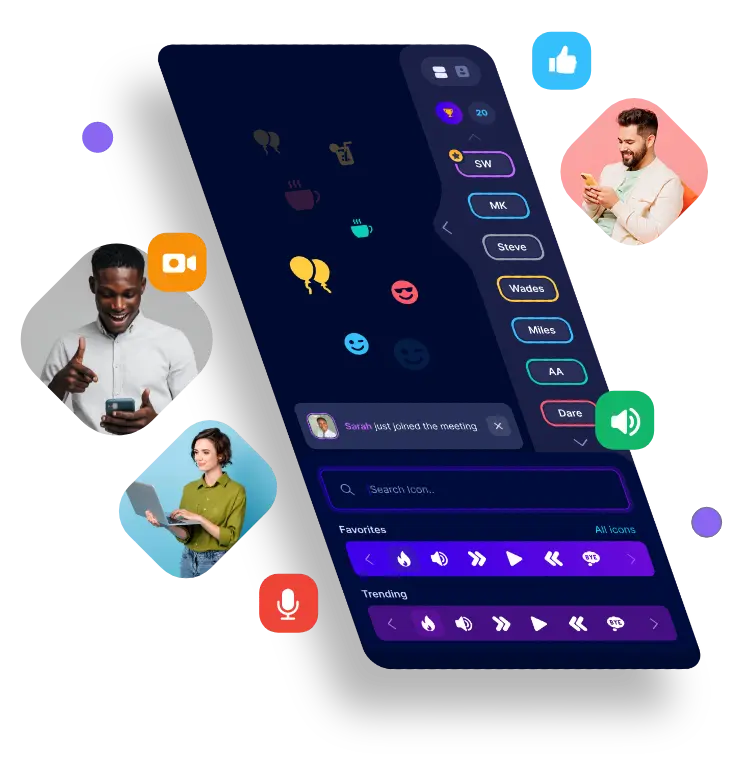
Ice Breaker Generator
Need fresh engagement ideas for your meeting or event?
Use our AI-powered ice breaker generator to effortlessly boost engagement.

Curious about how you can foster meaningful connections through ice breakers? Even if you are a seasoned presenter, it can be a challenge to find that one question that will engage the audience. Our AI powered Ice Breaker Generator makes it easy.
Instructions
Difficulty Level: ⚫ ⚪ ⚪ ⚪ ⚪
-
- Type your text into the box below. Share the context, topic, format, and vibe of the event. The chatbot may ask you a few followup questions.
- Want to save your answers? Use the copy button on the right side of each response to copy the text.
- Enter the ice breaker question and answers into the Townhall PRO polling tool to share with your meeting participants.
Ice Breaker Generator
PRO TIP: Be specific! Include particular details to see what the AI generates.
The Townhall Zoom app is the easiest way to give ice breakers in Zoom meetings
We track the data for you. You’ll see your participants answers AND a score for how much that ice breaker boosted virtual engagement.
Get a FREE consultation with Townhall experts today or try the Townhall Zoom App on your own!
Want more AI Tools?
Looking for creative ways to use ice breakers?
In a world where social interactions can sometimes feel awkward and distant, ice breakers have emerged as a valuable tool to bridge the gap and foster meaningful connections. Whether in a professional setting, social gathering, or team-building activity, ice breakers play a pivotal role in initiating conversations, creating rapport, and setting the stage for open communication. Here are a few different ways to use ice breakers in creative ways:
- Virtual Introductions: Use ice breakers to kick off a virtual meeting by asking participants to introduce themselves in a fun and engaging way. You can assign each person a unique prompt, such as sharing their favorite travel destination or a hidden talent. This allows participants to get to know each other beyond their professional roles, fostering a sense of connection and creating a more welcoming virtual environment.
- Fun Facts Ice Breaker: Start the meeting with a quick round of fun facts where participants share interesting or unexpected things about themselves. It could be a unique hobby, an unusual experience, or a fascinating fact related to their background. This activity not only breaks the ice but also encourages personal sharing and sparks conversations among participants.
- Virtual Show and Tell: Ask participants to find an item within their immediate surroundings and share why it is meaningful or interesting to them. This virtual adaptation of the classic "Show and Tell" activity allows participants to showcase a personal object, sparking conversation and providing insights into their lives. It creates a relaxed and interactive atmosphere while fostering connection and curiosity among the group.
- Polls and Quick Questions: Utilize polling features or ask quick ice breaker questions to engage participants. You can ask simple questions related to their preferences, such as favorite movies, books, or vacation destinations. Participants can respond using chat or polling tools, and the facilitator can share the results, encouraging discussion and creating a sense of camaraderie.
- Virtual Scavenger Hunt: Organize a virtual scavenger hunt by providing participants with a list of items or categories to find within their immediate surroundings. For example, they may be asked to find something yellow, something related to their favorite hobby, or something that represents their work. Participants can then share their findings with the group, sparking conversation and providing a lighthearted and interactive start to the meeting.
OUT-OF-THE BOX IDEAS
Chlup, D. T., & Collins, T. E. (2010). Breaking the ice: Using ice-breakers and re-energizers with adult learners. Adult Learning, 21(3-4), 34-39.
"Imagine That" Ice Breakers: Ask participants to describe the shape of a wish, the color of today, the feeling of favorite song, or the taste of happiness
"Bumper Sticker" Ice Breakers: Ask participants to summarize after learning a new concept or experience. How would those thoughts be stated on a bumper sticker?
Supporting a Culture of Inclusion
Creating an inclusive ice breaker is crucial to ensure that all participants feel comfortable, respected, and included. First, avoid sensitive topics that may be divisive or exclusionary, such as politics or religion. Instead, focus on universal themes that promote positivity and shared experiences. Respect personal boundaries by being mindful of physical contact and the level of personal information participants may wish to disclose. Make sure to use inclusive language, avoid assumptions or stereotypes, and ensure that all participants feel represented and included in the examples and language used.
THE WORST ICEBREAKER
Reddit Post: What’s the worst icebreaker/activity you’ve ever had to do?
"We had to choose a partner (a stranger), sit crosslegged with our knees touching, and stare deeply into each other's eyes for about 25 minutes (no laughing or talking allowed). Then we had to take turns complimenting each other. There was some other stuff that I think I've blocked out due to the trauma. It certainly broke the ice, but it also broke me a little bit."
Next, provide options for participation to accommodate different communication styles. Include opportunities for verbal, non-verbal, and written interactions, allowing participants to engage in ways that suit their preferences. Finally, foster a supportive atmosphere where participants feel safe and comfortable sharing their thoughts and ideas. This can be established through ground rules that encourage respectful behavior and active listening and create an environment where everyone's input is valued and acknowledged.
As always, seek feedback from participants after the ice breaker and continuously strive to create a more inclusive environment by adapting and evolving your approach.
